
Contra is a 1987 run and gun video game developed and published by Konami for arcades. A home version was released for the Nintendo Entertainment System in 1988, along with ports for various home computer formats, including the MSX2. The arcade and computer versions were localized as Gryzor in Europe, and the NES version as Probotector in the PAL region.

Salamander, retitled Life Force in North America and in the Japanese arcade re-release, is a scrolling shooter arcade video game developed and published by Konami. Released in 1986 as a spin-off of Gradius, Salamander introduced a simplified power-up system, two-player cooperative gameplay and both horizontally and vertically scrolling stages. Some of these later became normal for future Gradius games. In Japanese, the title is written using ateji, which are kanji used for spelling foreign words that has been supplanted in everyday use by katakana. Contra, another game by Konami was also given this treatment, with its title written in Japanese as 魂斗羅.

Operation Wolf is a light gun shooter arcade game developed by Taito and released in 1987. It was ported to many home systems.

Commando, released as Senjō no Ōkami in Japan, is a vertically scrolling run and gun video game released by Capcom for arcades in 1985. The game was designed by Tokuro Fujiwara. It was distributed in North America by Data East, and in Europe by several companies including Capcom, Deith Leisure and Sega, S.A. SONIC. Versions were released for various home computers and video game consoles. It is unrelated to the 1985 film of the same name, which was released six months after the game.

Rush'n Attack, also known as Green Beret in Japan and Europe, is a run-and-gun and hack-and-slash video game developed and released by Konami for arcades in 1985, and later converted to the Nintendo Entertainment System and home computers. Its North American title is a play on the phrase "Russian attack" due to its Cold War setting. It was ported to home systems and became a critical and commercial success for arcades and home computers.

P.O.W.: Prisoners of War, released in Japan as Datsugoku -Prisoners of War-, is a side-scrolling beat 'em up game produced by SNK and originally released as an arcade game in 1988.
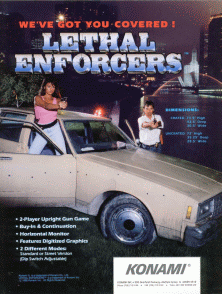
Lethal Enforcers is a 1992 light gun shooter released as an arcade video game by Konami. The graphics consist entirely of digitized photographs and digitized sprites. Home versions were released for the Super NES, Genesis and Sega CD during the following year and include a revolver-shaped light gun known as The Justifier.

M.I.A.: Missing in Action is an action arcade game released by Konami in 1989. The game is a spiritual successor to Green Beret. The game is influenced by popular action films of the time such as Commando, Rambo: First Blood Part II, and Missing in Action.
Gradius is a series of shooter video games, introduced in 1985, developed and published by Konami for a variety of portable, console and arcade platforms. In many games in the series, the player controls a ship known as the Vic Viper.

Laser Invasion, released as Gun Sight (ガンサイト) in Japan, is a multi-genre first-person action game released by Konami for the Nintendo Entertainment System in 1991. The player takes control of a military operative who pilots an attack helicopter in order to infiltrate various enemy bases and fulfill his mission. The game supports the standard NES controller, as well as the NES Zapper light gun and the LaserScope, a voice-activated headset controller Konami released for the NES that was compatible with all light gun games released for the system. The American version of the game featured a rebate for the LaserScope in the instruction booklet.

TwinBee is a vertically scrolling shooter released by Konami as an arcade video game in 1985 in Japan. Along with Sega's Fantasy Zone, released a year later, TwinBee is credited as an early archetype of the "cute 'em up" type in its genre. It was the first game to run on Konami's Bubble System hardware. TwinBee was ported to the Family Computer and MSX in 1986 and has been included in numerous compilations released in later years. The original arcade game was released outside Japan for the first time in the Nintendo DS compilation Konami Classics Series: Arcade Hits. A mobile phone version was released for i-mode Japan phones in 2003 with edited graphics.

Xexex, released as Orius in North America, is a 1991 side-scrolling shoot 'em up arcade game by Konami. It draws on Irem's R-Type and Konami's other shoot 'em up Gradius, while adding the tentacle mechanics of Irem's other shoot 'em up XMultiply. In the game, players take control of the Flintlock space fighter in a mission to rescue Princess Irene La Tias of Planet E-Square, who has been captured by the evil galactic warlord Klaus Pachelbel.

Top Gun: The Second Mission, released in Japan as Top Gun: Dual Fighters, is the video game sequel to Top Gun, also produced by Konami for NES. It was released in Japan on December 15, 1989, in North America in January 1990, and in Europe and Australia on October 24, 1991.
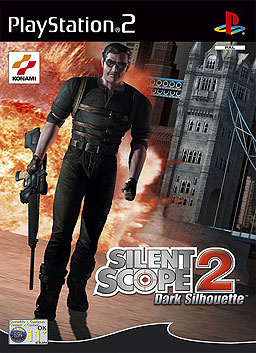
Silent Scope 2 is a 2000 rail shooter video game by Konami that is the sequel to the arcade game Silent Scope.
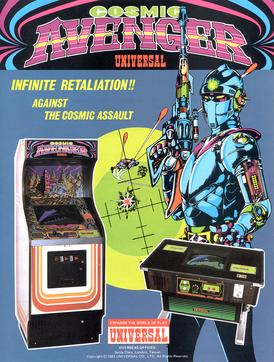
Cosmic Avenger is a scrolling shooter developed by Universal and released as an arcade video game in July 1981. It is part of the first wave shooters with forced horizontal scrolling which followed Konami's Scramble and Super Cobra from earlier in the year. It was released the same month as Vanguard. The final installment in Universal's Cosmic series, players take control of the Avenger space fighter and, as in Scramble, use bullets and bombs against enemy air and ground forces. The world is one continuous level made up of different areas.
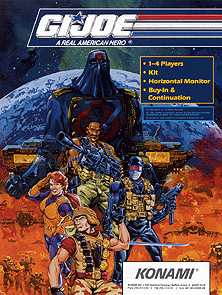
G.I. Joe is a third-person rail shooter video game produced by Konami and released in 1992 for video arcades. It is based on the cartoon series G.I. Joe: A Real American Hero and stars four characters from the show: Duke, Snake Eyes, Scarlett, and Roadblock.

Super Contra, known as Super Contra: The Alien Strikes Back in Japan, is a run and gun video game by Konami, originally released as a coin-operated arcade video game in January 1988. It is the sequel to the original Contra and part of the Contra series. The game stars Bill Rizer and Lance Bean as they are sent to thwart another alien invasion from the vicious Red Falcon.

Metal Gear is an action-adventure stealth video game developed and published by Konami for the MSX2. It was released for the system in Japan and parts of Europe in 1987. Considered to have popularized the stealth game genre, it was the first video game to be fully developed by Hideo Kojima, who would go on to direct most of the games that followed in the Metal Gear series. A reworked port of the game was released for the Famicom a few months later, which later saw release in international markets for the NES over the following two years; this version was developed without Kojima's involvement and features drastically altered level designs, among other changes.
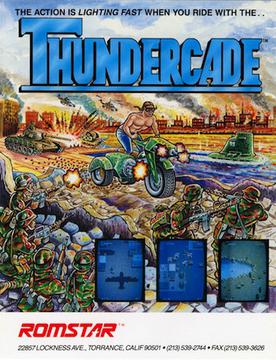
Thundercade, also known as Twin Formation and 特殊部隊UAG", is a vertically scrolling shooter developed by SETA and released as an arcade game in 1987. A version for the Nintendo Entertainment System from American Sammy was released in 1989.

Captain Commando is a 1991 beat 'em up game originally developed and published by Capcom as an arcade video game, and later ported to several other platforms. It was the seventeenth game produced for the company's CP System hardware. The game stars the titular superhero who was originally conceived as a fictional spokesman used by Capcom USA in the company's console games during the late 1980s. The game was included in Capcom Beat 'Em Up Bundle compilation title, which was released digitally for Nintendo Switch, PlayStation 4, Xbox One, and Windows in September 2018.


















